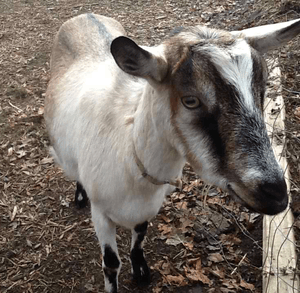Alpine goat


Alpine is a breed of domestic goat known for its very good milking ability.
They are of medium size and have no set markings. They have horns, a dish-face and erect ears.
The breed originated in the French Alps. Mature does weigh around 61 kg or 125 lbs, and are about 0.8 m or 30 inches tall at the shoulder. Alpine goats can range from white or gray to brown and black. Alpine goats are heavy milkers. The milk can be made into butter, cheese, soap, ice cream or any other dairy product normally made from cow's milk . They are often used for commercial dairy production as well as homestead milk goats.
The French-alpine is also referred to as the Alpine Dairy Goat and registration papers for this dairy goat use both designations as they are synonymous. These are hardy, adaptable animals that thrive in any climate while maintaining good health and excellent production. The face is straight with a straight nose as most other European breeds of goats. Toggenburg color and markings, or all-white is discriminated against. Alpine colors are described by using the following terms:
- Cou Blanc - (coo blanc) literally "white neck" - white front quarters and black hindquarters with black or gray markings on the head.
- Cou Clair - (coo clair) Literally "clear neck" - front quarters are tan, saffron, off-white, or shading to gray with black hindquarters.
- Cou Noir (coo nwah) literally "black neck" - Black front quarters and white hindquarters.
- Sundgau - (sundgow) black with white markings such as underbody, facial stripes, etc.
- Pied - spotted or mottled.
- Chamoisee - (shamwahzay) brown or bay - characteristic markings are black face, dorsal stripe, feet and legs and sometimes a martingale running over the withers and down to the chest. Spelling for male is chamoise.
- Two-tone Chamoisee - light front quarters with brown or grey hindquarters. This is not a cou blanc or cou clair as these terms are reserved for animals with black hindquarters.
- Broken Chamoisee - a solid chamoisee broken with another color by being banded or splashed, etc.
Any variation in the above patterns broken with white should be described as a broken pattern such as a broken cou blanc.
Milk
The Alpine goat is referred to as the French Alpine goat. Known for its milk, the Alpine goat is famous for its rich dairy production. According to the British Medical Journal, Alpine milk contains the lowest fat content of all milks(3.1 g/ 250ml), including that of Human’s and cows. It is higher in sugars than cows' milk but balances itself in terms of the amount of protein. Alpine Goats' milk has 2.3g of protein per 250ml while Cow’s milk has 3.4.[1] A higher protein count is not always good, since it packs more calories with an increased fat content. Compared to Saanen Goat Milk, it is higher in all nutritional aspects, except the fat content, making it a much healthier choice.[2]
The sexual maturation rate among Alpine goats is at four to five months after birth. When a goat reaches this age they are meant to mate, weighing 65-75 pounds. At this point the goat is eight – ten months old. A goat pregnancy lasts for 145 – 150 days, in which she produces two baby goats.[3]
Alpine goats are one of the top milk producers, alongside Saanen and Toggenburg goats. They are distinct from the other two due to their low value of fat content.[3] This could be a direct correlation between the weight of the animal and its habitual environment. Unlike the Nubian goat, whose weight is similar to that of the Alpines at maturity, yet produces a lower milk value with an increased fat content.[3]
According to Penn State university, the peak periods for milk production occur after four to six weeks of puberty.[3] The optimal weight at which a goat produces optimal milk production is 130 pounds. For the Alpine goat that number is higher at 135 pounds and produces 2,134 pounds of milk per lactation.[3] Good nutrition, proper milking procedures, reproductive management, and disease control are also factors that contribute to milk production of the Alpine Goat.
There are four requirements according to Penn State that need to be efficient for optimal dairy production. Dairy goats must be housed in specific conditions so that their milk production is not alarmed by changes. Changes in external factors can cause a decrease in milk production due to the pressure applied on the goat to adapt to these changes. The four factors for optimal production are; adequate ventilation, dry beds, uncontaminated feeder and water supply, minimal labor and disturbance.[3]
Alpine milk, as with all goat milk, must be filtered and chilled immediately upon separation from the lactating doe when intended for human consumption. The temperature at which milk will remain the best is at 4.4 degrees Celsius.[3] Cooling is required immediately of the milk so that there is no excess bacteria growth. Warm bacteria grows at a faster rate and multiplies so that the milk is spoiled. The milk that is refrigerated has a shelf life of about three to four weeks. However, consumers like to freeze the milk and increase its shelf life by about four to five weeks.
References
- ↑ "Goat's Mik". The British Medical Journal 1 (2894): 855–856. June 17, 1916. doi:10.2307/25317145. Retrieved April 2, 2014.
- ↑ Leite de Souza, Evandro; Rita de Cássia Ramos do Egypto (March 27, 2014). "Comparative Protein Composition Analysis of Goat Milk Produced by the Alpine and Saanen Breeds in Northeastern Brazil and Related Antibacterial Activities". PLoS ONE 9 (3): 2. doi:10.1371/journal.pone.0093361. Retrieved April 2, 2014.
- ↑ 3.0 3.1 3.2 3.3 3.4 3.5 3.6 State University, Pennsylvania. "Agricultural Alternatives: Dairy Goat Production". College of Agricultural Science. Retrieved April 2, 2014.